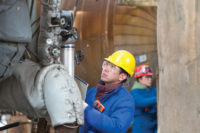Influencing safety…
140 characters at a time

The decision to go social
By now, there’s no question that social media has changed the way we do business. Posts like these have marketers and public relations professionals in nearly every industry scrambling to develop social strategies that will put them on the social media map. And while many companies have seen positive results such as increased sales or more qualified recruits, some are still questioning how social media fits into their business model.
The questions only multiply as social media continues to emerge as an increasingly important business asset. In the industrial sector, some common questions are: Is our target market using social media? If so, then how? If not, should we get involved in social media at all?
Successful social strategies
Some companies have jumped right in and are now using social media to create brand awareness, increase customer satisfaction, attract more media coverage, and most importantly, increase revenue. They are successful in regularly sharing engaging, thought-provoking content via social media channels, which leads to conversations with their customers, as well as conversations between customers about them.
According to Gini Dietrich and Geoff Livingston, authors of “Marketing in the Round,” social networks can also help add a personal touch to companies’ brand images “…whether it’s wacky and fun or serious and responsive…it enables you to provide that critical human element that corporate marketing is often unable to convey.”
Best of all, social media has the ability to cultivate a group of core customers with whom you regularly engage to foster even stronger relationships. These customers become your biggest fans and are willing to tell their success stories about your products and services time and time again. Conversely, by listening to the target audience as they interact with social media, companies can now uncover any issues regarding their products, services, etc., and take quick action to improve the customer experience.
Impact in the industrial arena
This all sounds well and good, but the question still looms as to how impactful social media can be in the industrial world. After all, many industrial professionals are of the baby-boom generation and are thought to have little to no social media presence. But according to research recently conducted by social media researcher Tom Webster and Edison Research, from 2011-2012 the biggest growth of any age cohort using social media was 45-55 years old. Further, 55 percent of Americans now have a profile on a social networking site. In other words, more than 170 million people, and not just kids, are using social media in the U.S. today.
GlobalSpec recently conducted its third annual Social Media Usage Survey of engineering, technical, manufacturing and industrial professionals, and found that although the use of social media for work-related purposes among this audience is focused on a few select platforms, adoption is steadily increasing.
For example,
- Participation on LinkedIn grew from 37 percent in 2010 to 55 percent in 2011.
- On Facebook, the most widely adopted social media platform among industrial professionals, users continue to mix work-related and personal activities. 60 percent “like” businesses within their industry, 39 percent participate in work-focused discussions and 37 percent read job-related activities.
- 29 percent of industrial professionals have already created accounts on Google+, a social media platform that debuted only last year.1
Target your audience
This steady growth suggests that it is time for more industrial companies and those who serve them to focus on integrating social media tools into their marketing plans. By listening to where your target audience participates, you can decide which channels are worth the investment of time and resources. If you focus all your efforts on gaining more Facebook fans and “likes” when your target audience has little presence on Facebook, you are less likely to see real business results.
A corporate blog is ideal for those who wish to share industry best practices, latest trends, new product developments, etc. Blogs also help to position organizations as thought leaders with experts who become the go-to resource for all things related to their specific industry. For example, in the gas detection industry, the expert author of one blog is able to answer nearly any question related to the use of gas detection instruments and accessories. Visitors can then comment on the author’s posts and continually converse about a range of topics related to gas detection.
LinkedIn groups, such as the one mentioned above, have also proven to be a valuable resource for industry professionals. The “Gas Detection Systems Professionals” group currently has more than 1,872 members and welcomes end users of gas detection systems, system integrators, specifying engineers, suppliers and employees or representatives of manufactures that sell and design gas detection systems. Companies might also consider creating LinkedIn user groups for their specific products and services, providing members the opportunity to network and open up dialogue on their experiences with a company.
YouTube videos can assist companies in communicating nearly any message in a creative and engaging way. Video content can range from customer testimonials to product demonstrations and can be embedded on other web pages for easy access.
No matter the mix, social media enables companies, regardless of industry, to get their messages out to customers faster than ever before. And the GlobalSpec survey results suggest that customers are seeking out these messages more than ever before. Sixty-one percent of respondents indicated that they use social media to keep abreast of the latest company, product and technology news.
A powerful resource
While I am by no means a social media expert, I am a marketer of gas detection products and services, and part of a movement that aspires to eliminate death on the job in this century. With more than 170 million participants in the U.S. alone, social media certainly has the power to influence the safety of our workers, 140 characters at a time.
Looking for a reprint of this article?
From high-res PDFs to custom plaques, order your copy today!








